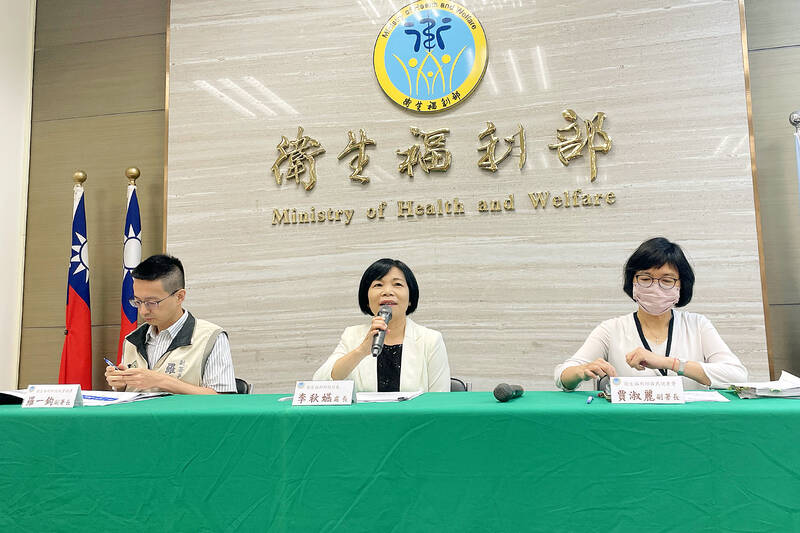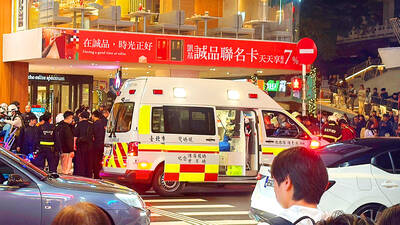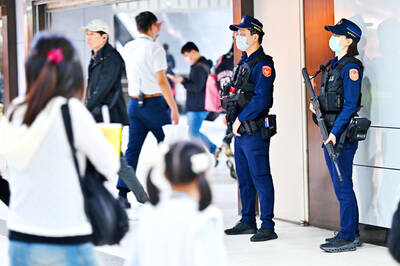Cancer remained the leading cause of death in Taiwan last year, marking its 41st consecutive year at the top of the list, while COVID-19-related deaths became the third-biggest cause, the first time it was included in the top 10 causes, the Ministry of Health and Welfare said yesterday.
The second-leading cause of death was heart disease (excluding hypertensive disease), data released by the ministry’s Department of Statistics showed.
The remaining seven were: pneumonia, cerebrovascular disease, diabetes, hypertensive disease, accidental injuries, chronic lower respiratory disease and kidney disease.

Photo: Chiu Chih-jou, Taipei Times
Last year, 51,927 people died of cancer, which is 271 more than the previous year, raising the cancer incidence rate by 1.2 percent to 222.7 per 100,000 people, the data showed.
A total of 157,267 people died of the 10 leading causes, accounting for 75.5 percent of total deaths, or 208,438 people, last year.
The total number of deaths increased by 24,266 people last year from the previous year, Department of Statistics section head Lu Shu-chun (呂淑君) said.
The main reasons were the local COVID-19 outbreak and an aging population, as 90.2 percent of the deaths were people aged 65 or older, and 55 percent among them died of COVID-19 complications.
The top 10 causes of cancer deaths and rankings last year remained the same as the year before, with tracheal, bronchial and lung cancers topping the list, followed by liver and bile duct cancers, and colorectal and anal cancers.
Health Promotion Administration (HPA) Deputy Director-General Chia Shu-li (賈淑麗) said that Taiwan’s “cancer death clock” last year sped up by three seconds — one person died of cancer every 10 minutes and seven seconds on average.
The number of deaths caused by colorectal, prostate and ovarian cancers all increased, she added.
The number of HPA-funded cancer screening tests for adults conducted last year significantly decreased by about 720,000 people, which could have been caused by people being less willing to get tested during the pandemic, she said.
The HPA encourages people to get regular tests to detect precancerous lesions or early-stage cancer and get treatment as early as possible, she said.
In countries where large-scale COVID-19 outbreaks occurred earlier in the pandemic, the virus’ ranking among the leading causes of death has dropped, such as the in US — ranking at the top in 2020 and 2021, but falling to sixth last year — and in the UK — ranking third in 2020 and 2021, but slipping to fourth last year, Lu said.
In Taiwan, COVID-19 was the 38th-biggest cause of death in 2020 and 19th in 2021, but it soared to third last year because of a large-scale outbreak, she said.
Centers for Disease Control Deputy Director-General Philip Lo (羅一鈞) said that 86.3 percent of COVID-19-related deaths last year were people aged 65 or older — 41.3 percent aged 85 or older, 27.8 percent aged 75 to 84 and 17.2 percent aged 65 to 74 — and that most of them had not received a booster vaccine.
There have so far been 5,157 confirmed COVID-19 related deaths this year, he said.
For the full year, COVID-19 is expected to remain on the list of the top 10 causes of deaths, but its ranking is likely to be lower than last year, Lo said.

TRAGEDY STRIKES TAIPEI: The suspect died after falling off a building after he threw smoke grenades into Taipei Main Station and went on a killing spree in Zhongshan A 27-year-old suspect allegedly threw smoke grenades in Taipei Main Station and then proceeded to Zhongshan MRT Station in a random killing spree that resulted in the death of the suspect and two other civilians, and seven injured, including one in critical condition, as of press time last night. The suspect, identified as a man surnamed Chang Wen (張文), allegedly began the attack at Taipei Main Station, the Taipei Fire Department said, adding that it received a report at 5:24pm that smoke grenades had been thrown in the station. One man in his 50s was rushed to hospital after a cardiac arrest

SAFETY FIRST: Double the number of police were deployed at the Taipei Marathon, while other cities released plans to bolster public event safety Authorities across Taiwan have stepped up security measures ahead of Christmas and New Year events, following a knife and smoke bomb attack in Taipei on Friday that left four people dead and 11 injured. In a bid to prevent potential copycat incidents, police deployments have been expanded for large gatherings, transport hubs, and other crowded public spaces, according to official statements from police and city authorities. Taipei Mayor Chiang Wan-an (蔣萬安) said the city has “comprehensively raised security readiness” in crowded areas, increased police deployments with armed officers, and intensified patrols during weekends and nighttime hours. For large-scale events, security checkpoints and explosives

A car bomb killed a senior Russian general in southern Moscow yesterday morning, the latest high-profile army figure to be blown up in a blast that came just hours after Russian and Ukrainian delegates held separate talks in Miami on a plan to end the war. Kyiv has not commented on the incident, but Russian investigators said they were probing whether the blast was “linked” to “Ukrainian special forces.” The attack was similar to other assassinations of generals and pro-war figures that have either been claimed, or are widely believed to have been orchestrated, by Ukraine. Russian Lieutenant General Fanil Sarvarov, 56, head

PUBLIC SAFETY: The premier said that security would be tightened in transport hubs, while President Lai commended the public for their bravery The government is to deploy more police, including rapid response units, in crowded public areas to ensure a swift response to any threats, President William Lai (賴清德) said yesterday after a knife attack killed three people and injured 11 in Taipei the previous day. Lai made the remarks following a briefing by the National Police Agency on the progress of the investigation, saying that the attack underscored the importance of cooperation in public security between the central and local governments. The attack unfolded in the early evening on Friday around Taipei Main Station’s M7 exit and later near the Taipei MRT’s Zhongshan